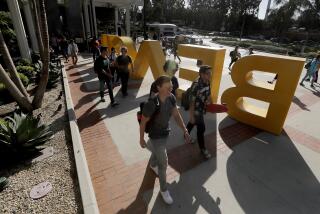Cal State Cuts Estimate for New Campus
- Share via
CAMARILLO — Bracing for a money shortage, California State University planners say they have found a way to launch a campus in Ventura County for less money than anticipated--a revelation they hope will help persuade trustees to support the conversion of Camarillo State Hospital into a four-year college.
By calling for less renovation at the state hospital, planners have slashed millions off the original $40-million-to-$45-million price tag of transforming the shuttered psychiatric facility into the county’s first public university.
Cal State officials now say they can develop the campus and accommodate about 6,000 full- and part-time students for construction costs of $25 million to $30 million.
The cost estimates are key as Cal State University trustees close in on the deadline for deciding whether to turn the state hospital into the university system’s 23rd campus.
A Cal State committee on campus development is set to consider the issue next week, and committee members could forward the conversion proposal to the full Board of Trustees for approval in September.
In examining the financial details of the proposal, however, some trustees have questioned the risks associated with business ventures--from a conference center to a kingergarten-through-eighth-grade magnet school and a sprawling retirement community--being pitched to help subsidize the campus.
Those concerns were heightened recently as planners discovered that some of those enterprises may not generate as much money as was forecast earlier this year.
“We now know that this property is no gold mine,” said Mary Stephens, executive project manager for the developing Cal State Channel Islands campus. “As we see the numbers being less and less certain, we’ve been trying to find ways to bring the costs down.”
What Cal State planners have done is rethink ways to use the hospital property, and recalculate the space that will be needed to open the campus.
*
As originally proposed, Cal State officials planned to renovate 300,000 square feet for classroom space and other academic-related purposes.
To help pay for that work, officials proposed a range of income-generating ventures, including a program to lease unoccupied buildings to private businesses and research firms.
Money generated by those and other ventures would go to repay the debt on three bond issues--of $10 million to $12 million each--sold to generate cash for the conversion.
But some of those ventures have not panned out the way planners predicted. Cal State officials had forecast that lease revenues would total $1.4 million by June 30, 1999. Now they estimate that those revenues would be closer to $400,000 by that time.
Facing the prospect of a revenue shortfall, Cal State planners have scaled back the renovation proposal to 200,000 square feet--a move that would save $10 million to $12 million and would reduce the need for development to help subsidize the campus.
But even with less square footage, officials said, they would be able to educate the same number of students as originally envisioned by employing a range of innovative methods such as distance learning, where classes are offered off-campus via closed-circuit television.
“We’re going to assume that we’re going to be able to use technology to educate more [students] and not just focus on bringing bodies onto campus,” Stephens said. “What it comes down to is that this is still the least expensive way to bring a four-year university to Ventura County.”
*
Despite the reduced price tag, Cal State trustees still must decide whether to funnel an additional $6 million to $8 million a year to help meet the campus’ operating expenses.
Trustee Jim Considine, chairman of the Cal State committee that will consider the issue next week, said the decision to push forward with the project probably will hinge on whether the state is willing to make a long-term commitment to fund the Channel Islands campus.
“I think it can work,” Considine said. “You know it would cost $800 million to $1 billion dollars to duplicate that existing plant facility. To take an asset that is basically going to be boarded up, or probably turned into a prison the way things are going, and turn it into a university for a cost of less than $40 million is a good deal in my opinion.”
In the meantime, Cal State planners will continue work on an aggressive marketing campaign aimed at stirring interest among investors in the campus.
Stephens said the university has had to overcome a credibility gap in selling itself to business partners. Because a campus has been talked about for more than three decades in Ventura County, she said, some people are leery about whether it will happen.
*
“It’s not just if you build it they will come,” Stephens said. “The university has to be there, it has to prove itself.”
To that end, Cal State officials have contracted with Encino-based Capital Commercial Real Estate to help form business partnerships at the site.
The real estate firm is scouring the region for organizations interested in sharing space at the campus and thus helping shoulder overhead expenses of the 700-acre hospital campus with more than 80 now-vacant buildings.
Steve Doll, Capital’s assistant vice president in Oxnard, said there will be plenty of interest in the university once trustees commit to developing the campus.
“The site practically sells itself,” he said. “But I think certainly, when they cross that hurdle, that will really make things take off.”
More to Read
Sign up for Essential California
The most important California stories and recommendations in your inbox every morning.
You may occasionally receive promotional content from the Los Angeles Times.










